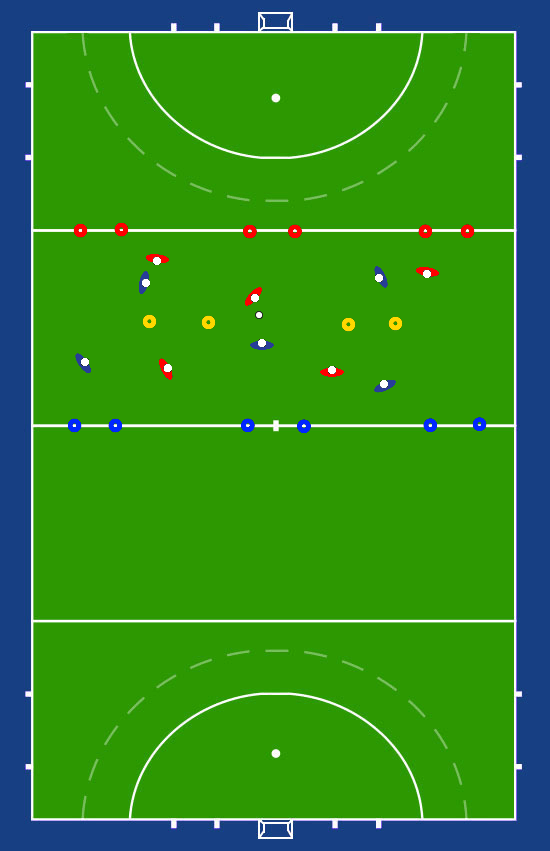Hockey drills
- Purpose; passing over large distances, while running. Finishing and tackleback.
- A plays long pass to B,
- B drives the ball to the right and plays through to C who shoots at goal.
- Once the shot has been completed, the next player on A passes to D
- and D starts a dribble towards the goal (scoring past penalty spot),
- C defends this attack.
- Rotation: A1BCDA2
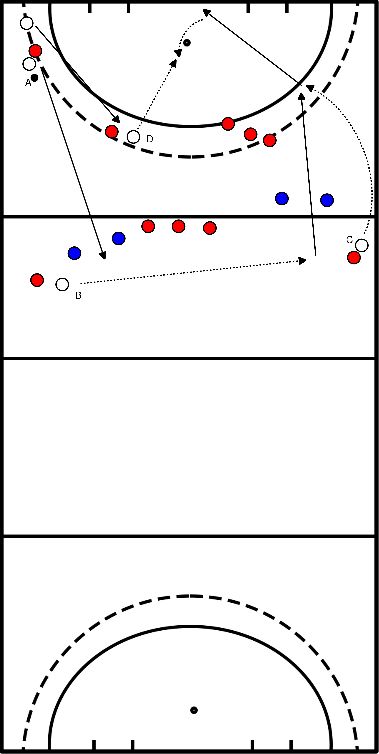
- Defender plays the ball to the right back.
- Right half pulls in and right front goes deep.
- Defender gives a deep pass on the right front.
- Right front turns away and plays the ball back on the midfielder.
- Midfielder puts the ball back on the other central defender who comes in.
- Pass to left back and then perform the same exercise as over right.
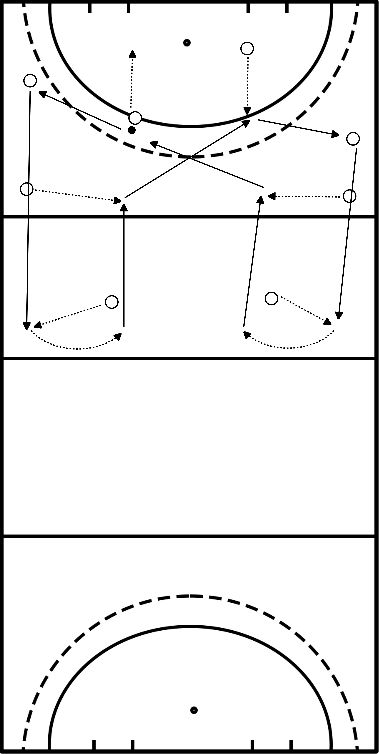
INSTRUCTIONS
- 2 teams
- 5 players per team
- 3 goals per team
- 2 yellow independent goals in the centre of the pitch
- Game: team blue against team red.
- Team red scores at one of the 3 blue pilons and team blue scores at one of the 3 red pilons.
- When the ball goes through one of the two yellow goals, the goals turn around.
- Team blue scores at the blue pilons and team red scores at the red pilons.
- When the ball goes through one of the yellow goals again, it turns around again.
AREAS OF CONCERN
Ball possession Take a good look at which of the 6 goals there's a lot of free space
Not in ball possession Trap the player with the ball from multiple sides
- 3 v 2 :
- ball speed is important as is the shortest way to the goal
- make a triangle with one player wide and one player up high to stretch the field
- look for the 2 v 1
- defenders work together and defend in zone
- 4 v 3 :
- make sure where you want to play
- make game-like positions: Center mid, left mid, center striker and left forward
- ball speed
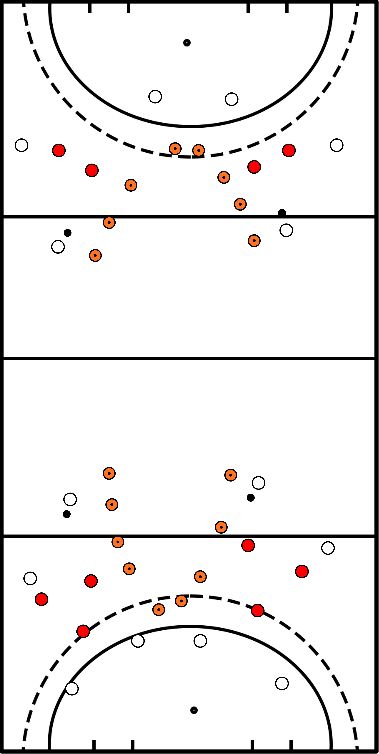
Game with different variations:
- with grip
- with globe
- with stick in weird position
- with other balls
- Each player takes a pilon.
- Fields of about 10x5 are made.
- The pilon is placed in the middle of the back lines.
The aim is to play past your opponent and dribble the ball over the pilon. IT IS NOT ALLOWED TO SHOOT FROM 10 METERS!
The winner goes one square to the right and the loser goes one square to the left. Rounds of -/+ 2 minutes
- It works just like a normal game only now there's a square in the middle.
- If a shot or other foul is made, or if the ball has been out of bounds, the trainer throws/plays in a new ball from inside the square.
- The ball does not necessarily go to the same team or at the place where the foul was made.
- The size of the field depends on the number of players.
Aim:
To become physically as well as technically warm as preparation for the training.
Set up:
The exercise will be done with a maximum of 4 people. Of course you can put a multiple of these so that the exercise still works.
1. The players 1 start with the ball and play it to their players 2. Then they change positions.
2. Players 2 play the ball back to players 1 and also change positions.
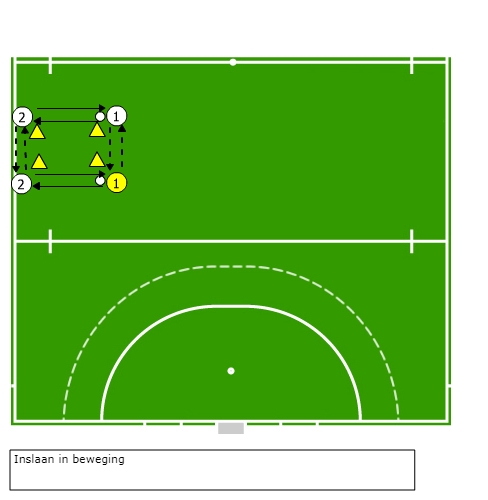
Variations:
- You can vary the way of passing (hitting, push, flats)
- Increase the distance between the pilons that players only has to run further.
- Increase the distance between the pilons that players have to pass over longer distances
- Increase both distances.
- Increase speed.
- Make as many successful passes as possible in time.
Points of attention:
- Sit low for a good control.
- Stick to the ground at ball control.
- Play the ball on the forehand side.
- Stand still while performing a ball control.
- Balls are at the first pilon.
- The player at the first pilon passes the ball to the second pilon,
- who pushes the ball through the pilons to the third person.
- The third person runs in on the ball and runs even further,
- then he pushes the ball to person 4 while he's running.
- Person 4 runs around the pilons and passes the ball at the top of the circle,
- where person 5 has just run up to finish the ball in the goal.
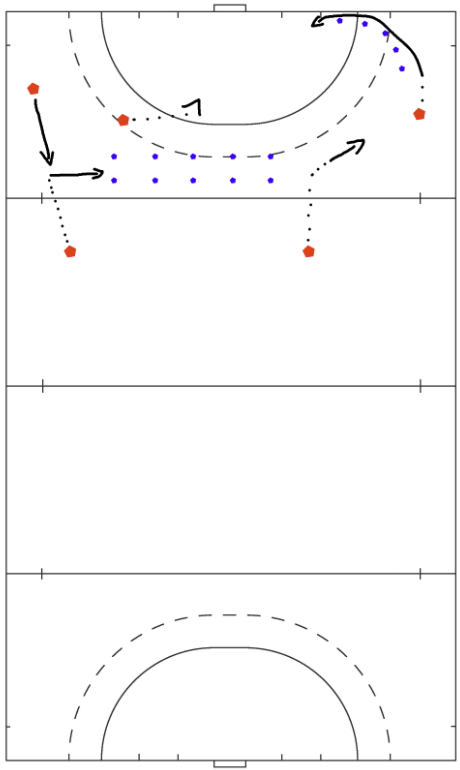
Aim:
Getting warm through a combination of passing, running and controlling the ball while running or standing still.
Set up:
This exercise also known in volleyball. The pilons are not quite in a triangle. It is possible, depending on the number of players, to set up multiples of the exercise.
1. The player at A plays the ball straight on to the player at B.
2. The player at B plays the ball to the player at C and runs towards point A.
3. The player at C receives the ball at point D and passes it to point A.
4. For the substitution A goes to B, B via D to C and C to A.

Variations:
- The stroke can be varied. (hitting, push, flats)
- The distances can be increased or decreased to adjust the level of difficulty.
- Pilons can be placed to play in between. This to increase the accuracy. When you make the pilons smaller, the difficulty increases.
- To play the ball from C to D, it can be bounced.
- To play the ball from D to A, it can be bounced.
- You can also place point C on the other side so that you turn backhand and forehand.
- When you place point C in 90 degrees from point B, you can rotate the same exercise only then from a different angle at point D.
- When you put down different situations, you can let the exercise rotate. Situation A is the standard, with situation B the exercise is mirrored, with situation C the exercise is set up in such a way that point B and C are at 90 degrees from each other and situation D is a mirror of situation C.
Points of attention:
- As a trainer you can take a good look at the different techniques of your players.
- Sit low when controlling the ball
- When playing the ball from C to D, the ball must not pass too far in the direction of A. The aim is for the player coming from B to take the ball at right angles.
- Play where possible on the forehand.
- Stand ready to control the ball. (low to the ground, stick on the ground)
Aim:
- To become physically as well as technically warm as preparation for the training.
Design:
- The exercise will be done with a maximum of 4 people.
- Of course you can put a multiple of these so that the exercise still works.
- The players 1 start with the ball and play it to their players 2. Then they change positions.
- Players 2 play the ball back to players 1 and also change positions.
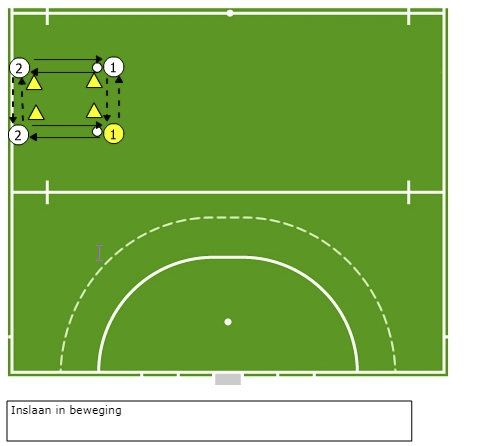
Variations:
- You can vary the way of passing (hitting, push, flats)
- Increase the distance between the pilons so that one only has to walk further.
- Increase the distance between the pilons so that one only has to move on.
- Increase both distances.
- Increase speed
- Make as many successful passes as possible in time.
Points of attention:
- Sit low for good control.
- Stick to the ground at ball control.
- Play ball on the forehand side.
- Stand still at ball acceptance.
- Place pilon to form a little slalom.
- Increase speed
- customize slalom
- finish at goal at the end of the slalom










